Mark Sisson's Blog, page 331
August 4, 2013
Weekend Link Love
 Research of the Week
Research of the WeekDespite health officials being worried about the “increase in meat intake in Asian countries,” a recent study actually found an inverse association between mortality and red meat, fish, and poultry intake.
Forget melatonin supplements, blue blocking goggles, and f.lux - going camping is the best way to normalize your circadian rhythm.
Even though tests of individual chemicals may proclaim them as “safe,” combining “safe” doses of two potential carcinogens – estrogen and arsenic – doubles the cancer risk to prostate cells. This study seems relevant in a world where “we are getting exposed to many chemicals at once,” doesn’t it?
Interesting Blog Posts
Ned Kock explains why he thinks grain-fed beef liver might be even more nutritious than grass-fed beef liver.
Everyone should learn at least a couple helpful tips from this list of 25 food prep techniques.
Media, Schmedia
Famously gluten-free tennis star Novak Djokovic expands on his regimen. Suffice it to say, he’s an interesting dude.
Health experts are recommending the instatement of a new saturated fat tax in New Zealand to curb the dangerous national pastime of consuming grass-fed butter and promote a greater intake of vegetable oil. I’m sure this will go swimmingly.
This success story from a Montreal man made my day.
Everything Else
Does evolution actually punish selfishness?
Even though his adamantium-laced spinal column is nigh indestructible, Hugh Jackman still insists on deadlifting with proper form (and in VFFs, no less).
Recipe Corner
If you decide to make Paleo sloppy joe sweet potatoes, you’d better eat with your hands and eschew napkins. The “sloppy” is the best part.
You’ve all tried cauliflower fried rice, but what about cauliflower rice with a Moroccan flair?
Time Capsule
One year ago (Aug 4 – Aug 10)
32 “Slow Living” Inspired Ways to Savor Summer – Summer’s leaving, folks, and you should figure out a few ways to savor your remaining time with it.
Why You Should Lift and Lower Heavy Things – Jonathan Bailor guests stars and explains why lifting and lowering heavy things is so essential (with an emphasis on the lowering).
Comment of the Week
This post bugs me.
- Even though your comment got *crickets* as a response, I liked it.
Get Your Omega-3s: Order Two Bottles of Primal Blueprint Fish Oil Capsules and Get An Additional Bottle Absolutely FREE

August 3, 2013
Pickled Shrimp
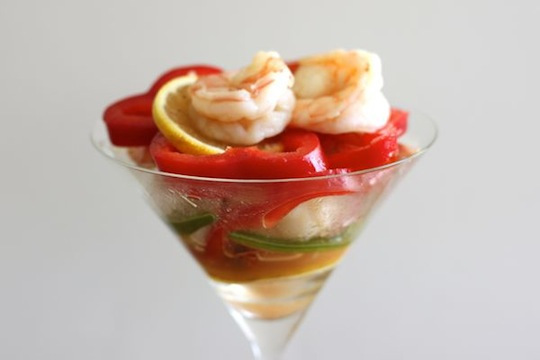 If you’ve grabbed one too many handfuls of nuts or jerky when the munchies strike and you’re craving something new to snack on, here’s an idea: ice-cold, pickled shrimp. Firm and fresh with a tangy kick of lemon and vinegar plus subtle spices, this Southern specialty tastes especially good when the weather is hot.
If you’ve grabbed one too many handfuls of nuts or jerky when the munchies strike and you’re craving something new to snack on, here’s an idea: ice-cold, pickled shrimp. Firm and fresh with a tangy kick of lemon and vinegar plus subtle spices, this Southern specialty tastes especially good when the weather is hot.
Pickled shrimp aren’t only an answer to snacking boredom. You’ll also get a decent amount of protein, selenium, calcium and iodine. Dip deeper into the vinegary marinade for crisp slices of sweet red pepper or spicy jalapeño and a dose of lycopene and vitamins C and B.
Beyond snacking, pour pickled shrimp over salad greens or shredded cabbage for a full meal.
Servings: 4 as an appetizer or snack
Time in the Kitchen: 25 minutes, plus up to 24 hours to marinate
Ingredients:
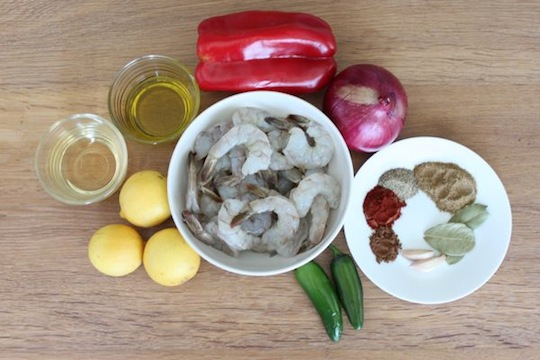
1 pound raw shrimp (26 to 30 count) peeled and deveined, tail left on or pulled off, your choice (450 g)
2 teaspoons celery salt, divided (10 ml)
1 teaspoon black pepper (5 ml)
1 teaspoon paprika (5 ml)
1/4 teaspoon allspice (a pinch)
2 cloves of garlic, thinly sliced
1/4 cup fresh lemon juice (60 ml)
2 tablespoons unseasoned rice wine vinegar (30 ml)
1/2 cup extra virgin olive oil (120 ml)
1 lemon, thinly sliced
1/2 red onion, thinly sliced
1 red pepper, thinly sliced
2 jalapenos, seeded and sliced
3 bay leaves
Instructions:
Set out a large bowl of ice water.
Bring 1 teaspoon (5 ml) celery salt and the black pepper, paprika and 6 cups (1.4 L) water to a boil.
Once the water is boiling reduce the heat to low, add the shrimp and cook just until the shrimp turn pink, about 2 minutes.
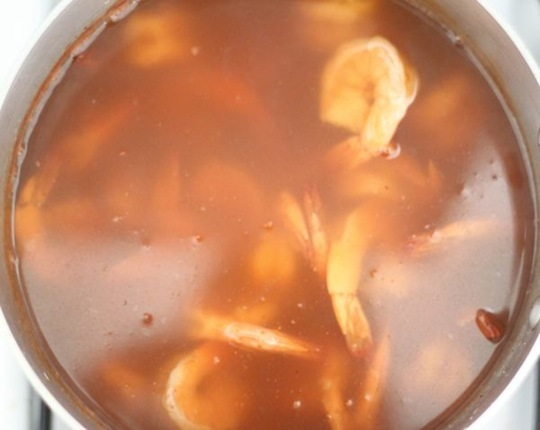
Drain and transfer the shrimp to the bowl of ice water to chill down. Immediately drain again.
In a medium-sized bowl whisk together remaining 1 teaspoon celery salt (5 ml), allspice, garlic, lemon juice, vinegar and olive oil.
Mix together the shrimp, lemon slices, red onion, red pepper and jalapenos. Pour the marinade on top and add the bay leaves. This works best in a shallow dish with a lid, so the shrimp can be turned or shaken a few times while marinating. Or, just throw everything together in a sealed plastic bag. If you feel like you need more liquid to cover the shrimp and veggies, add more oil. Only add more vinegar or lemon juice if you want the shrimp to have an extra-tangy flavor.
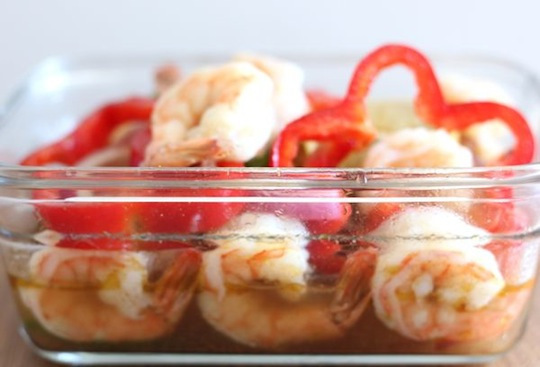
For the most flavor, chill 24 hours before serving.

Not Sure What to Eat? Get the Primal Blueprint Meal Plan for Shopping Lists and Recipes Delivered Directly to Your Inbox Each Week

August 2, 2013
Where Are They Now?
It’s Friday, everyone! And that means another Primal Blueprint Real Life Story from a Mark’s Daily Apple reader. This week we’ll be catching up with a couple of our old friends to see how they’ve been doing on their Primal journeys.
If you have your own success story and would like to share it with me and the Mark’s Daily Apple community please contact me here. I’ll continue to publish these each Friday as long as they keep coming in. Thank you for reading!
 Hi Mark,
Hi Mark,
This is Marie Bencivenga. Around two years ago you featured my husband, Nick, and me as Friday Primal Success Stories. I thought you might like an update. We have been Primal the entire time since you published our success stories, and continue to love the lifestyle. I’m writing to you now, because one year ago today I suffered a terrible accident. That accident taught me a lesson that I did not expect, and now feel like I need to share with the masses. Many people discuss how the Primal lifestyle has healed them of diseases and internal problems. I learned how being Primal healed my body when it was seriously wounded.
{Warning: Some of the images below are graphic and not for the faint of heart.}
It was a Sunday night and we had an old friend for dinner. I had pots and pans going on every burner, and I unfortunately made the mistake of placing my pot of boiled potatoes on the front burner. The potatoes had been boiling for a few minutes when I went to stab a fork in one to see if it was soft. I did not notice the pot was off center, and when I pushed down, the back of the pot flipped up, dousing my entire front with boiling water. While I immediately stripped off my clothes, it was too late. I had second and third degree boil burns on 5% of my body – the entire right half of my stomach, starting an inch or two above the belly button, all the way down to my panty line, and then also my right thigh. I’ve attached photos with descriptions – please note they are graphic.
My skin bubbled up instantly. Within 36 hours the blisters were over 1 1/2″ – 2″ high off my body. I was terrified at what was happening to my body but the thing I can never describe properly was the amount of pain I was in. Searing, constant, blinding, mind-numbing pain. I could not bend. I could not engage my abdominal muscles at all. I could not sit or walk. I was not strong enough to lift a glass full of water on my own. At that point I was admitted to the burn center at St. Francis Hospital in SF. My doctor came to the conclusion that the risk of infection was too high and that the blisters would burst on their own. They needed to scrape and clean the wounds. They did this without me using painkillers – I cannot tolerate strong medications as they make me nauseous and I hallucinate. Eventually, they found a low dose of Vicodin that I could handle without nauseousness, but I still hallucinated. I limited the use of those pain killers as much as I was able. I was wrapped in silver impregnated bandages to ward off infection, and while a hospital bed was offered to me, I chose to return home.
I was told I was lucky. That with a burn, feeling pain is a good sign – it means that the nerve endings are exposed instead of damaged. I did sustain some nerve damage on my right thigh. I was told that I can now experience a bullet wound and childbirth without fear since “this pain was worse”. I was also told to expect my body to never be the same. That I would be permanently scarred, and that while they would do what they could for scar management, that I should expect a long recovery and to carry these scars with me my whole life.
Coming home from the hospital all I could think about was my pain and my food. Sweet potatoes. Fatty fish and shrimp. I craved dark leafy greens. I wanted nothing to do with sugar or fruits. I wanted tea and cinnamon. Dairy was a daily part of my life but once I was hurt I didn’t want it very much at all. I took psyllium husk and probiotics to combat the negative side effects of the pain killer. My husband and mother provided me with the necessary 24 hour care the first two weeks of my injuries and they helped me maintain 100% Primal.
Every 3-5 days I would return to the burn center to have my wounds cleaned and redressed. Every time the doctor examined me, he was amazed at how quickly I was healing. Even with his encouragement, it took 6 weeks of laying flat on my back before my wounds were healed enough for me to re-engage my life at an extremely reduced capacity. Six months of recovery with little to no exercise followed. I could walk – slowly. I had been indoor rock climbing, biking, and hiking frequently before the accident. Despite the lack of movement and exercise I did not gain a pound during my recovery. I lost a bit of muscle definition but it quickly returned once the go ahead to exercise again was given to me by my doctors.
My doctor provided me with excellent care and thanks to his generosity I underwent a few laser procedures to minimize the scarring. I wore a compression outfit under my clothes for months to keep it from raising or twisting. My leg especially was forming bad scars – purple, splotchy, twisted scars. I maintained my Primal eating habits, kept the scars from any sun exposure, and continued treating my body to the best foods available. Once the wounds were healed fully I would rub coconut oil on the scars. My doctor again and again accredited my good dietary habits to my healing. He showed me pictures of others who had similar damage – my wounds and then scars were more advanced in the healing process.
One year later I am back to normal. The scars on my stomach are minimal – you can’t tell they are there unless you are scrutinizing my skin. At a normal distance they are unnoticeable. My scars on my leg have also lightened up considerably and while you can still see that something is there, you’d have no idea the extent of the wound that the scars originated from. I believe that as I age they will continue to diminish, possibly completely. This goes against what I was told to expect.
I fully believe being Primal before, during, and after this ordeal meant all the difference to my healing process. I was not the only one convinced either. My mother had listened to me exalt the Primal lifestyle for over a year without being convinced, but witnessing my recovery and hearing my doctor’s comments opened her mind. She has been Primal since last August and has lost 50 pounds successfully, as well as bouncing back quickly from a serious surgery of her own.
I tell everyone who’ll listen about my experience and beliefs that Primal is the way for me. I’ve maintained my weight at 120 lbs (down from 160) for over two years despite this accident and the 7 1/2 months of no exercise that went along with it. I never feel like I am missing anything in my diet and I love making all my family members and friends Primal meals and treats – and they all love eating my healthy, grain-free alternatives to traditional SAD recipes. I am so grateful to you, Mark, and all the other amazing sources of knowledge that I’ve used to make Primal work for me. I now know without any doubt that this lifestyle is in my best interest on so many fronts – I’ll be a Grokette for life.
Photos of Marie
Nick and me in 2009, before going Primal. I was 160 lbs.

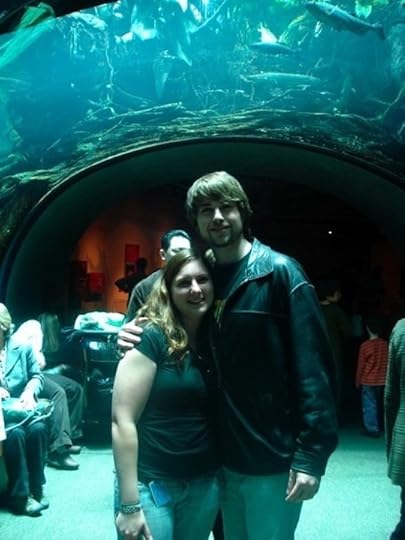
Nick and me in July 2012, one week before my accident. We had been Primal since March of 2011. I was 120 lbs.

My burn blisters within 36 hours of initial contact with the boiling water.
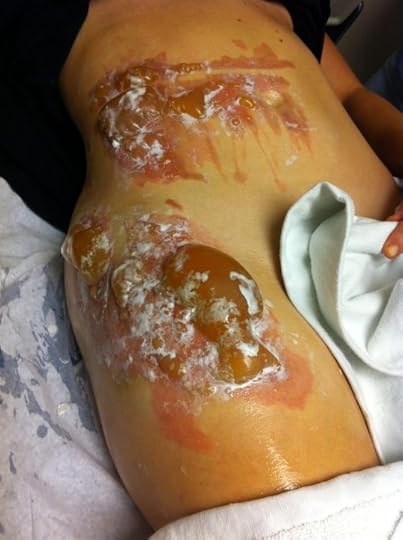
Two days after they scraped the blisters off and cleaned my wounds. The grayish-brown is dead tissue.

The silver bandages tarnished my skin. This is one week after I was burned. It was the first time I saw myself bleeding from my injuries.
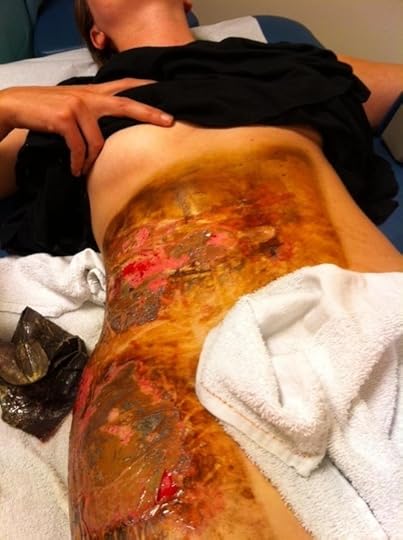
Two weeks after the incident I had substantial scabbing form. I would have to clean and peel off dead skin and scabs during my hospital sessions. Only I could tell by feel what was ready to be removed. They wanted as much scab removed as possible to keep the new skin flat and un-rippled.

Three weeks after the burn, new skin was forming. It was very thin and would split often.
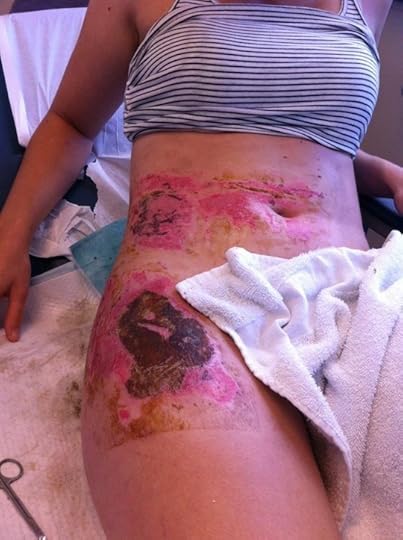
One month after the burn. Much of my new skin was raw and would bleed regularly, especially on my leg where I sustained my most severe injuries.

Six weeks after my burn. My stomach wounds had closed but my leg wounds would still spilt open and bleed.

My scars today are minimal, almost invisible on my stomach.
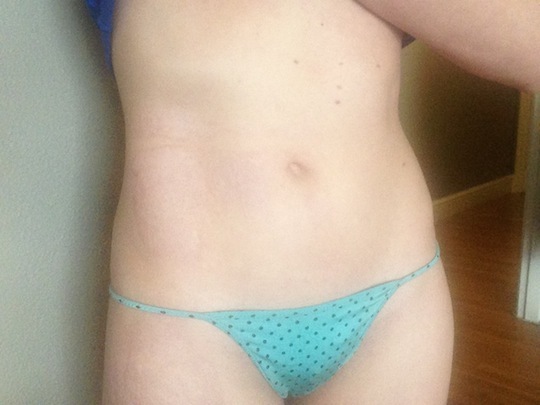
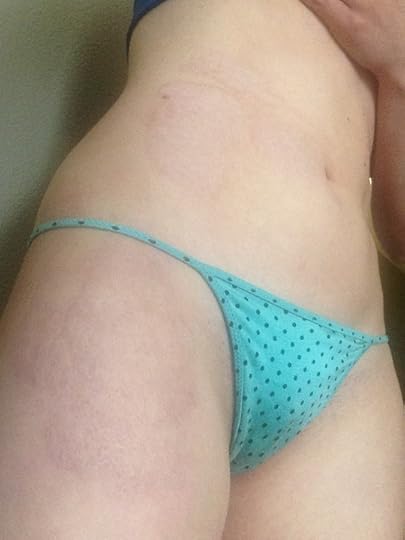
How I look these days (with clothes on!). I am still 120 lbs.


Marie Bencivenga
___________________________________________________________________________
Mark,
You featured me back in January 2011 on your blog and I wanted to send you an update to my progress. Here is the original blog you posted:
By Switching to Primal You Can Save on Your…
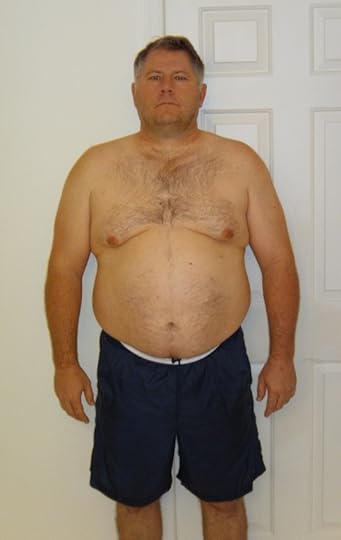
Since then I have continued to make improvements and at age 50 I have never felt better. After reading quite a bit about CrossFit type workouts on your site I joined a local CrossFit gym, CrossFit Draper (Draper, UT) in August 2012. I have enjoyed the challenges of the CrossFit workouts as well as the camaraderie experienced in that setting. It is like having a workout team and a personal trainer all rolled into one.
I have continued enjoying my long, slow hikes in the mountains about twice a week for 3 to 5 miles per outing. My favorite hike is still the steep 4.5 mile round trip to the lower falls in Bells Canyon in Sandy, UT – a 1600 foot elevation gain climb that I am doing (round trip) in about 75 minutes now (well, it seems slow…).
I continue to eat Primal with above ground veggies and grassfed/range free meats as my base and enjoy “sweets” like dark chocolate, berries and kombucha when I get a craving for something sweet.
At 50, I took on a few new challenges this year to help me continue to feel motivated. I ran the 33k Moab Red Hot in February and this past weekend (June 29th) I participated in the Utah Spartan Beast finishing the 12+ mile course in just over 3 hours (3:04) putting me 11th in the 50 to 55 year old men. I honestly joined just hoping to finish…
This past year my wife, Marilyn, has come on board 100% Primal with me which has made things great for the two of us. She is my workout partner, my hiking buddy, and my true soulmate.
Not sure what else I can add here but my sincere gratitude Mark. Your website, emails, recipes, blogs, and inspirational stories have been the foundation I have built upon during this lifestyle transformation. Thank you for all you do for me and my wife. We truly thank you, Mark.
Friends and family that haven’t seen me in a long time ask me what diet I’m doing. My simple answer is that I don’t diet…diets don’t work. I explain that you have to change who you are and now I AM PRIMAL.
All the best my primal brother!
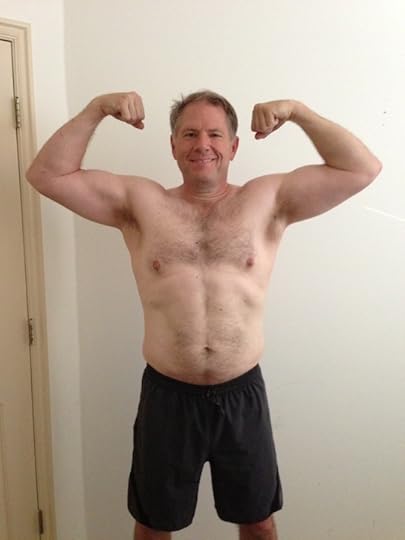
Randy Oveson
Get Your Omega-3s: Order Two Bottles of Primal Blueprint Fish Oil Capsules and Get An Additional Bottle Absolutely FREE

August 1, 2013
How To Overcome the Naysayers in Your Life
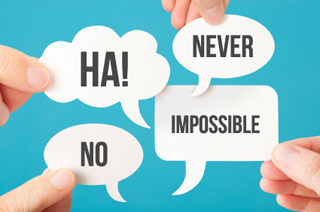 It’s inevitable at some point. Beyond the safe and sympathetic community of MDA and other like-minded cadres, we move through the rest of the world on a day to day basis. It’s likely we even stick out at times. Some of us go barefoot when/where it’s socially unacceptable. Some of us (not me, thank you very much!) sleep on the floor. A few of us have squatting toilet accessories in our bathrooms. A number of us have assembled small CrossFit style gyms in our cubicles. Others store an astounding supply of lard or homemade jerky in our homes. We tend to skip the bread course in a restaurant – perhaps the most controversial of all choices…. When people notice what we’re eating or not eating, how we’re exercising, when and where we’re sleeping, they might begin to wonder (especially if we’re wearing a “live long, drop dead” t-shirt). When they begin to wonder, they often want to ask. Many do. Some, scandalized or seized by concern, may caution, direct or cajole. Sometimes they mean well. Sometimes they’re just mean. How do we deal with the naysayers in our lives? Who are these people, and how do our responses vary given our relationships? Think for a minute. Then sit back with your Primal egg coffee and entertain these possibilities.
It’s inevitable at some point. Beyond the safe and sympathetic community of MDA and other like-minded cadres, we move through the rest of the world on a day to day basis. It’s likely we even stick out at times. Some of us go barefoot when/where it’s socially unacceptable. Some of us (not me, thank you very much!) sleep on the floor. A few of us have squatting toilet accessories in our bathrooms. A number of us have assembled small CrossFit style gyms in our cubicles. Others store an astounding supply of lard or homemade jerky in our homes. We tend to skip the bread course in a restaurant – perhaps the most controversial of all choices…. When people notice what we’re eating or not eating, how we’re exercising, when and where we’re sleeping, they might begin to wonder (especially if we’re wearing a “live long, drop dead” t-shirt). When they begin to wonder, they often want to ask. Many do. Some, scandalized or seized by concern, may caution, direct or cajole. Sometimes they mean well. Sometimes they’re just mean. How do we deal with the naysayers in our lives? Who are these people, and how do our responses vary given our relationships? Think for a minute. Then sit back with your Primal egg coffee and entertain these possibilities.
Your Partner/Family
You love them. They love you. You disagree on some basic lifestyle issues like whether it’s healthy to eat 450 grams of carbs every day. The disagreement itself isn’t the issue. Emotion says worry for the people you care about. Wisdom says let go of what you can’t control. What happens, however, when they’re the ones who won’t let it go and the old “live, let live” mantra doesn’t keep the peace? If your nearest and dearest are your biggest naysayers, consider the following.
Double dog dare them to try a 30-day Challenge.
Yup. Go big or go home. This can work with the big personalities in your family or maybe your partner (if he/she relishes a good competition). Their diet against yours for whatever poundage, performance or medical measurements you want. I know a husband and wife team who did it this way and upped the ante. The Primal guy asked for a large screen T.V. as his prize. His wife, a CW-advocate, asked for a trip to New York. Let’s just say the guy will be enjoying fall football on the big screen, and his wife has a new appreciation for lower carb living. (Happy ending: they’re also planning a conciliatory trip to NYC this fall.)
Tell your success/success-in-the-making story.
Sure, you can show them the numbers from all your latest blood tests, weigh-ins, and workout routines. What matters the most to the people who love us best, however, is our happiness. Put aside logic and reasoning. Tell them what living Primal means to you – the same way you would tell the MDA community. Whether you’ve made significant strides or are just beginning, open up and let them know the motivation you have to make this happen and the good you’ve experienced. Ask for support and let them know the naysaying is raining on your Primal parade. Get them involved. Put a before photo up and ask them to take updated ones along the way or otherwise help you keep track of your progress. They still may cringe at the Brussel sprouts in bacon fat, but they’ll love the chance to bond.
Your Friends
Of course it depends on the kinds of friends. Truth be told, I don’t believe we owe acquaintances much justification, and they generally don’t expect much. Any arguments are less about your well-being and more about being right. As they say, you don’t have to participate in every argument you’re invited to. That said, for closer friends (the ones who really are motivated to care about your health and happiness), I think the answer is often one part “caring detachment” and one part casual suggestion.
Accept (and share) that it’s not your job to convince them.
You’re not blowing someone off when you draw a healthy boundary that will keep your relationship focused on what matters – for the relationship. You won’t judge them, and you ask them to not judge you. Friendship is based on a respect for each other’s space and choices as much as it is on commonalities you share. Sometimes it really can be that easy. Most of what we think is our business in life isn’t our business, and everyone’s happier for that.
Share the fun stuff.
Sidestep the justifications, and just share the stuff that makes for good conversation (and understanding). How about making a meal for your buddies, or showing off your Primal Cravings cookbook? Keep the peace – and the fun.
Your Doctor
While we can tune out other “experts” in our lives if we so choose, it’s a little trickier when we’re sitting in our doctor’s office stuck on the paper sheet in the ugly gown. We feel like, well, a subject. We might come armed and ready to share our latest Primal successes, but in the time it takes for the nurse to do our vitals, we can lose all sense of agency. I think the key is to first let go of the need to be on the defensive and think about the larger purpose and benefits of the relationship.
Deal in numbers.
Accept that you’re coming at healthy living from a different vantage point. It’s really okay. Just because you’ve adopted various ancestral health practices doesn’t mean you should feel banished from all modern medical care. You deserve to be there. You can benefit from being there. When differing philosophies get in the way, get back to the numbers themselves. They tell a story – a large part of your story. That said, know the numbers you should prioritize. Bond over lab sheets. Talk technical stuff where it’s relevant.
Recast the relationship.
I know a lot of people who, if they can’t find a Primal friendly doctor, will mentally recast their relationship with their health care provider. Use him/her as a resource for certain information and as a means to access certain services. It’s okay to depersonalize it that way. Health care is a commodity. There’s nothing inherently wrong with taking a consumer based view of it. Make the relationship work for you, and do the rest of your Primal work elsewhere.
Yourself
Finally, sometimes we might find ourselves caught in our own web of naysaying – especially if we’re at the beginning of the journey. Understand that doubt isn’t a weakness. Recognize it instead of resisting it. Take it apart to appreciate it. My advice?
Accept it as part of the journey.
Living Primally doesn’t just happen. It unfolds. It comes together and unravels here and there and takes a new and better shape and then proceeds to the same hundreds of times over. That’s the work of any meaningful change in life.
Keep learning.
That goes for learning about Primal living and your own physiology. In my experience, truth feels right before you end up finding the right words for it. Be your own experiment. Question, explore, test, try. Don’t ever stop learning and trying.
Thanks for reading today, everyone! How have you learned to respond to naysayers in your life? Have they learned to back off over time? Have you actually moved away from certain relationships?
Get Your Omega-3s: Order Two Bottles of Primal Blueprint Fish Oil Capsules and Get An Additional Bottle Absolutely FREE

July 31, 2013
25 Safer Alternatives to Common Cosmetics
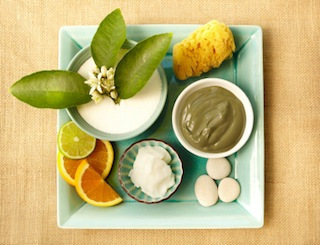 Two weeks ago, I introduced you to five cosmetics ingredients you should avoid. These are chemicals you’ll often find in things like shampoos, conditioners, deodorants, sunblocks, and makeups – you know, the stuff you’re covering yourself in everyday. Cosmetics manufacturers use these ingredients to improve their product’s ability to clean, moisturize, beautify, or improve an odor, but they often do lots of other bad stuff in the process. So the question is, do these products need these chemicals to work like we want them to, or are there alternative products that manage to use more natural and/or less harmful ingredients while still getting the job done? Indeed, there are, and today I’m going to share my findings with you.
Two weeks ago, I introduced you to five cosmetics ingredients you should avoid. These are chemicals you’ll often find in things like shampoos, conditioners, deodorants, sunblocks, and makeups – you know, the stuff you’re covering yourself in everyday. Cosmetics manufacturers use these ingredients to improve their product’s ability to clean, moisturize, beautify, or improve an odor, but they often do lots of other bad stuff in the process. So the question is, do these products need these chemicals to work like we want them to, or are there alternative products that manage to use more natural and/or less harmful ingredients while still getting the job done? Indeed, there are, and today I’m going to share my findings with you.
Now, it’s fairly common for people to switch over to a Primal lifestyle and find they just don’t feel the need for all the lotions, creams, concealers, and other body care products they used to wear. Some even ditch shampoo, deodorant, and soap altogether. Still, though, that’s not everyone. I regularly received reader requests for safe cosmetics recommendations. So let’s look at some of these safer alternatives. I’ll try to include every possible category that falls under the “cosmetics” umbrella, but if I miss anything, don’t hesitate to let me know in the comment board.
Makeup
When I say makeup, I refer to all those products people put on their faces, around their eyes, on their lips, and beside their noses. Powders and rouges and those sorts of things. Can you tell I know what I’m talking about? Anyway, the following brands are guaranteed to be free of the problem ingredients mentioned last time (plus most others).
100% Pure - They produce makeup and other cosmetics using food-grade plant-based ingredients (it’s safe to eat, so it’s probably safe to put on your body). They’ve also come up with their own preservative system to replace parabens, using a complex blend of herbs, vitamins, and antioxidants in place of industrial antimicrobials.
BiteBeauty - I like their mission – to create lipstick that you can safely eat (because women and the people who kiss them do eat a fair amount of lipstick) – as well as their propensity to quote Oscar Wilde. BiteBeauty uses great ingredients like argan oil and Manuka honey, and they even had their lipstick tested to ensure it was free of gluten and almost free of lead (total and utter elimination of lead is hard because lead is everywhere, including the food-grade ingredients they use).
Josie Maran - Argan oil-based makeup. They also use food-grade ingredients like avocado, coconut oil, olive oil, and mango seed butter.
Scotch Naturals - Many nail polish companies claiming to be free of phthalates actually aren’t, as a recent study revealed, suggesting that phthalates truly are hard to resist for nail polish makers. Scotch Naturals, however, is one of the only companies making truly non-toxic nail polish (that also happens to work really well).
Lavanila - They specialize in fragrance-free fragrances.
Pacifica Perfume - Another maker of safe fragrances.
Skin and Body Care
You’ve got your lotions, your creams, your face washes, your moisturizers, your body washes (isn’t that just a fancy name for soap?), and anything else that goes on your skin.
Weleda - Weleda grows the bulk of their ingredients in their own biodynamic gardens. All in all, they’ve got acres of gardens scattered across the world, including Germany, Netherlands, Brazil, New Zealand, and Argentina. This allows them to grow hundreds of species of medicinal plants from a variety of climates.
Dr. Bronner’s - No, it’s not Dr. Bonner’s. It’s Bronner, and it’s made with all organic ingredients, mostly oils, including coconut, olive, peppermint, and jojoba. I don’t think you need much else other than this stuff. You can use it as regular soap, hand soap, shampoo, and even toothpaste. Just be careful with the liquid peppermint soap on the, ahem, sensitive areas of your body. You might want to dilute it. Dr. Bronner’s slightly crazy tendency to rant and rave on his bottles also makes for fantastic shower reading.
Suki - Drawing on an impressive list of plant-based ingredients, Suki makes “skincare systems” for every skin type.
Indigo Wild - They’re best known for their Zum Soap, made from goat’s milk, but the rest of their rapidly expanding skin care line is safe and effective.
Primal Life Organics - This is a skincare line made by a Primal/paleo adherent who’d been making personal care products for years before she decided to make a business of it. Everything is paleo, gluten-free, and vegan.
Burt’s Bees - Unfortunately, very few of their products are bee-based. It’s just a clever name, I guess. Still, everything is free of harmful chemicals, and the products are widely available in regular stores.
Trillium Organics - Trillium Organics is organic, obviously, with a line of non-toxic body care products, but they also make treatments for specific conditions, like acne, rosacea, eczema, dermatitis, and diaper rash.
Speaking of soaps, what about replacements for anti-bacterial handsoaps containing triclosan? As I said last time, triclosan actually is quite effective at targeting bacteria. If your hands are crawling with roving bands of disease-causing microbes, then, yeah, a triclosan blast will take care of them and leave you “better off.” Problem is all the other terrible stuff evidence suggests it does to our health. Luckily, we have this stuff called “soap and water” that does a fair job at cleaning our hands when they’re dirty.
Research shows that triclosan-containing hand soaps are “no more effective than plain soap at preventing infectious illness symptoms and reducing bacterial levels on the hands,” even when you’re talking about something as pernicious and deadly as C. diff. There’s also that fact that triclosan kills the bacteria, thus providing a powerful selective pressure for future evolution of antibiotic resistance, while soap and water wash the bacteria off your hands and down the drain. Unless it begins selecting for clingier bacteria who can hang on to human skin better, there’s no danger of antibiotic resistance developing from basic hand washing with regular soap. Overall, basic soap is still best. Since some bacteria exposure is important for health, you probably don’t want to kill it all outright.
Hair Products
There’s an argument to be made in favor of going entirely without shampoo, but that doesn’t work for everyone. Some folks need/want shampoo and conditioner, only without the parabens and other toxic chemicals. People, even Primal people, also have the funny desire to style their hair into shapes, to stand in front of the mirror, tousle it and puff it up and make it stay in place. To look good, in other words (and not just naked). If you’re spraying your entire head with a mist of potentially toxic liquid to do that, you definitely want a safer option. Here are a few companies making hair products you can also use to style your hair, clean your hair, and make a good salad dressing.
Acure Organics - Acure offers face and body care, but they are best known for their organic shampoos and conditioners. The Moroccan argan oil and argan stem cell shampoo gets particularly high marks for being effective and non-toxic.
Yarok Hair - All the regular bad ingredients are absent from their line of shampoos, conditioners, and hair styling products.
DIY hair wax - This recipe uses beeswax and coconut oil to create a styling, moldable hair wax free of any toxic or unpronounceable ingredients.
Men’s Products
All of the cosmetics I’ve already mentioned can technically be used by men, but the average male won’t be applying much lipstick, mascara, or age-defying lotion, however edible and natural it may be. They are more likely to use “men’s products,” however. By men’s products, I refer to shaving products, beard care, cologne, and skin care targeted at men.
Eco-Beauty Organics - Men’s products are not their main focus, but they do offer a nice selection of aftershaves, lotions, and shaving creams.
OM4 - Organic Male makes organic skincare for men. This is a nice change of pace, since most other completely non-toxic men’s products are an afterthought for companies who focus on women.
Etsy – You can find some decent men’s colognes (plus other cosmetics, for that matter) on Etsy, like this one.
A decent homemade alternative to shaving cream, I’ve found, is a half teaspoon of really good extra virgin olive oil. The dogs (and Italian food buffs) you meet will, however, attempt to lick you.
Sunscreen
The alternative to chemical UV-filters are physical filters. You’ve got shade – umbrellas, clothing, hats, a roof over our head, that sort of thing that we all know about – and then you’ve got the physical filters that we apply to our skin: zinc oxide. These are the white shmears you see on beach-goers’ skin from time to time. You might have just thought they were really, really bad at rubbing in their sunblock, but they were just avoiding oxybenzone by using zinc oxide.
Zinc oxide is the most effective and safest UV-filter. It’s a purely physical filter, meaning it sits on top of your skin and prevents UV damage, acting as a physical barrier. It’s just as effective as a chemical filter like oxybenzone without the side effects. If you’ve already got enough unfiltered sunlight for the day’s vitamin D needs and want some UV protection, zinc oxide is your best, safest bet.
Some might worry about looking silly with white streaks all over their face and body. But, if you go the zinc oxide nanoparticle route, you can get a zinc oxide sunscreen that disappears on your skin. There is some concern that these nanoparticles of zinc oxide are absorbed transdermally and can cause health problems, but the evidence seems to weigh heavily toward the “all safe” side. One study found that while zinc oxide does penetrate some of the outer layers of the epidermis (more so when the skin is sunburnt), it does not achieve transdermal penetration for systemic distribution. Another concern is that some people have allergic reactions to zinc oxide.
Badger Balm - All their products are good, but the sunscreens are the most renown. They are very thorough with the science behind their sunscreens, and they run regular tests to confirm the safety of their zinc oxide formula. Best of all, they’ve managed to minimize the whitening without increasing the potential for toxicity.
Raw Elements Eco Formula - Active ingredient is zinc oxide. It’s thick, but stays on well even with water exposure and activity. Not too whitening, either.
Kabana Skincare - Another good sunscreen source that uses zinc oxide. They’ve even got a formula with added vitamin D, presumably to make up for the UVB you’re blocking. Not sure if that actually works, but it certainly can’t hurt.
Mexitan - They don’t just make non-toxic, zinc oxide-based sunblock. They also offer recommendations for beach resorts and produce safe self-tanner.
Deodorant
Some folks claim they can go without anything under their arms as long as their diet is “clean” enough, but I don’t know. I’d say it’s good practice to have something on hand, just in case your confidence turns out to be hubris. If you don’t want the aluminum, artificial fragrances, and other nasties found in regular products, you’ve got plenty of choices.
Primal Pit Paste - The best deodorant ever. It’s coconut based, so you can probably eat it in a pinch.
Thai Crystal - They’ve got a spray and a roll-on. Your choice. There’s some concern over whether it contains aluminum or not, but I don’t think it’s a huge issue unless you’ve just shaved your armpit and thus opened up a route for transdermal absorption.
Barring a product, you can also throw together your own:
Coconut and baking soda - Mix roughly equal parts of coconut oil and baking soda. It’s a bit goopy, especially in warm weather, but it gets the job done. I hear that adding some arrowroot flour or cornstarch will reduce the goopiness.
Obviously, this is far from being a complete list of all worthy alternatives. The demand for non-toxic cosmetics is only growing, and new companies are constantly emerging to address it. Be sure to leave your personal favorites in the comment section so that others can check them out.
If you’re curious about the products you use, or a new one that you’re considering, enter it on the Skin Deep database to learn about the safety (or toxicity) of its ingredients.
Thanks for reading!
Get Your Omega-3s: Order Two Bottles of Primal Blueprint Fish Oil Capsules and Get An Additional Bottle Absolutely FREE

July 30, 2013
Why Eating Insects Makes Sense
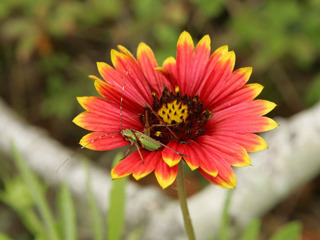 I’m grateful to have our friend Gabi Lewis, founder of Exo, pen today’s guest post. Exo is running a Kickstarter campaign to bring an insect protein bar to market. Learn more and donate here. (Full disclosure: I’m exploring the possibility of becoming an investor myself.) Enter Gabi…
I’m grateful to have our friend Gabi Lewis, founder of Exo, pen today’s guest post. Exo is running a Kickstarter campaign to bring an insect protein bar to market. Learn more and donate here. (Full disclosure: I’m exploring the possibility of becoming an investor myself.) Enter Gabi…
It’s a safe bet to assume that insects don’t feature prominently on your current menu. My aim in this post is to convince you that they absolutely should. Whether your goal is to most accurately replicate an ancestral diet, minimize the ecological impact of your food consumption, or simply optimize your own performance, eating insects just makes sense.
While it has gained renewed attention recently1, entomophagy – the consumption of insects – is nothing new. In fact, as eclectic omnivores, it’s likely that we’ve consumed insects, the most abundant terrestrial life form excluding bacteria, for an exceedingly long time. Evidence that our earliest ancestors ate insects includes analyses of fossilized feces from caves and the fact that all extant nonhuman primates are insectivorous2. Fast forward a few million years and Aristotle’s brain-food of choice was cicadas (packed with omega-3 fatty acids). Today, 80% of the world still eats over 1,600 species of insects, from Jing Leed in Thailand to Escamoles in Mexico to Casu Marzu in Italy. Deeply rooted in our history as a species, entomophagy is as primal as cave painting in a loin cloth (more so actually, since it predates tools).
There are additional convincing arguments for embracing entomophagy. Insects are exceptionally nutritious. They contain up to 91% protein by dry weight3 with amino acid compositions that are superior to most alternatives4. They are an excellent source of fat and are high in the essential fatty acids linoleic acid and linolenic acid5. Insects also tend to be high in micronutrients such as B-vitamins, beta-carotene, and vitamin E6. Crickets, for example, contain substantially more iron than beef. Considered purely from a nutritional perspective, eating insects is a no-brainer. There is even some evidence linking a departure from entomophagy in rural Mexico to the deteriorations in health of those concerned7.
Coupled with the health benefits of entomophagy are the environmental ones. The negative impact that livestock has on our planet is well documented; it accounts for 18% of all greenhouse gases, more than emissions from cars, trains, and planes combined8. As our population grows, these problems will only get worse. Insect protein, however, is uniquely sustainable for a number of reasons. First, insects are poikilothermic, meaning that they can match their internal body temperatures to the external environment and consequently exert less energy (meaning less feed) maintaining their body temperatures than their warm-blooded counterparts9. As well as requiring little feed, insects require barely any water. It takes 3,290 liters of water to produce 150g of beef, but virtually none to produce 150g of grasshopper protein10. Insects also have greater reproductive thrust than conventional livestock; a single female cricket can lay 1,500 eggs in four weeks11. For all these reasons, it’s estimated that Acheta Domestica (house cricket) is twenty times more efficient as a source of protein than cattle12.
I’ve outlined strictly rational arguments for entomophagy, but it would be naïve to ignore the cultural taboo that exists. In his 1885 manifesto, Why Not Eat Insects?, Vincent Holt worried that “it may require a strong effort of will to reason ourselves out of the stupid prejudices that have stood in our way for ages.” He found a theoretical solution in the idea that “fashion is the most powerful motive in the world,” and there are historical precedents to support this. Americans and Europeans considered sushi repulsive until an enterprising chef in LA replaced Toro with avocado and created the inside-out California Roll (disguising the raw fish inside). It spread from Hollywood to the rest of the country and on to Europe. Thirty years ago we would have viewed a plate of sashimi with revulsion; now most of us are willing to spend big bucks to get it.
We’re already starting to see fashion serve as a motive for behavioral change. Some of the world’s best restaurants regularly feature insects on their menu. Noma, located in Copenhagen and ranked the number one restaurant in the world for three years, has served a fermented cricket soy sauce, and its experimental arm, Nordic Food Lab, recently received at 3.6 million Kronor grant to explore gourmet entomophagy13. Inventions are appearing for raising your own edible insects at home14. There’s even talk of using insect protein for space travel and habitation15. My own company, Exo, launched a crowdfunding campaign yesterday. By creating protein bars made with cricket flour (slow roasted and finely ground crickets), we hope to create a vehicle to introduce entomophagy to the West – a kind of California Roll of insects.
It has been hypothesized that the West’s aversion to entomophagy comes from a subconscious desire to disassociate from our hunter-gatherer ancestors16. It is obvious, however, that to optimize human performance, we are well served by returning to practices that have, for thousands of years, influenced our genetic makeup. The Primal health community is built upon the intelligent and gradual reclamation of these practices, and entomophagy is the next step in the process. By overcoming our conditioned biases and utilizing insects as a more ecologically efficient protein source, we can shift eating patterns in a direction that is healthier for humans and better for the planet.
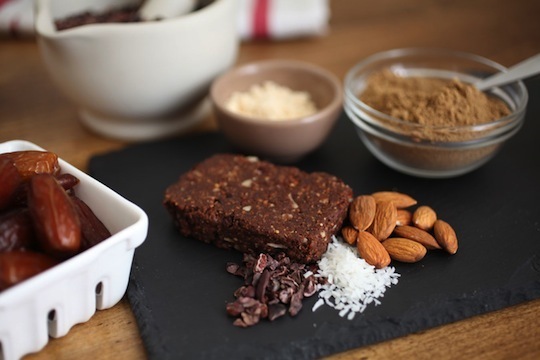
Exo launched a Kickstarter campaign on July 29th, with a goal of raising $20,000. Exo’s first protein bar, formulated with a three Michelin Star chef, contains cricket flour, almonds, dates, coconut, raw cacao, honey and sea salt. Support Exo here.
1Should We Eat More Insects? The U.N. Thinks So.
2Ramos-Elorduy B., (2009), The importance of edible insects in the nutrition and economy of people of the rural areas of Mexico. Ecology of Food and Nutrition, 36: 347-366.
3Bukkens SGF., (2005). Insects in the human diet. Ecological Implications of Minilivestock: Potential of Insects, Rodents, Frogs and Snails, 545–77.
4DeFoliart, G.R., (2002). The human Use of Insects as a Food Resource: A Bibliographic Account in Progress.
5Yang LF, Siriamornpun S, Li D., (2006). Polyunsaturated fatty acid content of edible insects in Thailand. J. Food Lipids 13(3):277–85.
6Banjo, A.D., Lawal, O.A., Songonuga, E.A., (2006). The nutritional value of fourteen species of edible insects in southwestern Nigeria. African Journal of Biotechnology, 5:298–301.
7Ramos-Elorduy, J., (1997). Insects: A sustainable source of food? Ecology of Food and Nutrition, 36: 247-27.
8Livestock a major threat to environment
9Lindroth, R.L., (1993). Food conversion efficiencies of insect herbivores. Food Insects Newsletter, 6: 9–11.
10Walsh, Bryan, (2008). Eating Bugs. Time.
11Capinera, J. L., (2004). Encyclopedia of Entomology. Kluwer Academic Publishers.
12Nakagaki, B.J,, DeFoliart, G.R., (1991). Comparison of diets for mass-rearing Acheta domesticus (Orthoptera: Gryllidae) as a novelty food, and comparison of food conversion efficiency with values reported for livestock. Journal of Economical Entomology, 84:891–6.
13Major funding awarded for edible insect research in Denmark
14Raise Your Own Edible Bugs With This Decorative Kitchen Pod
15Katayama, N., Yamashita, M., Kishida, Y., Liu, C., Watanabe, I. Wada, H., (2008). Azolla as a component of the space diet during habitation on Mars. Acta Astronautica, 63: 1093-1099.
16Vane-Wright RI., (1991). Why not eat insects? Bulletin of. Entomological Research. 81:1–4.

July 29, 2013
Dear Mark: How Are You Training These Days?
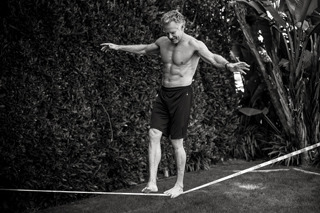 One of the most common questions I get from readers is the same one I get from people who have no idea who I am or what I do: “What’s your workout, dude?” Because I write a blog that discusses the latest fitness research, some of you might get the impression that I’m constantly switching up my routine to incorporate the latest and greatest. Many times, you assume that because I wrote approvingly about something, I must be doing that thing. Well, by and large, I am not doing that. Even if some particular lift is proven to build the most strength most efficiently, I mostly stick to my tried and true. I’m no longer an elite athlete. I don’t need the latest and greatest. If it works for me and my goals, I stick with it. Of course, it helps that the way I train was already fairly consistent with the latest research, and is easily fueled by my Primal Blueprint eating strategy.
One of the most common questions I get from readers is the same one I get from people who have no idea who I am or what I do: “What’s your workout, dude?” Because I write a blog that discusses the latest fitness research, some of you might get the impression that I’m constantly switching up my routine to incorporate the latest and greatest. Many times, you assume that because I wrote approvingly about something, I must be doing that thing. Well, by and large, I am not doing that. Even if some particular lift is proven to build the most strength most efficiently, I mostly stick to my tried and true. I’m no longer an elite athlete. I don’t need the latest and greatest. If it works for me and my goals, I stick with it. Of course, it helps that the way I train was already fairly consistent with the latest research, and is easily fueled by my Primal Blueprint eating strategy.
Here’s one of the latest inquiries into my training:
Are you sticking to strictly bodyweight workouts these days or do you still hit the gym once a week or so for a heavy weight session?
Chris
For the most part, yes: bodyweight training still comprises the core of my training. Pullups, pushups, squats, lunges, rows, assisted handstand pushups, planks, dips. I’ll sometimes throw on a weighted vest or play around with angles and leverage to increase the resistance, but those are the basic movements that I work on. While I generally try to find time to do these outside, I admit that I often do these in the gym, mostly because I enjoy the social interaction that I don’t otherwise get standing at my desk in my home office most of the day. In terms of actual equipment I use, I might do some dumbbell presses (I’ve mostly given up barbell pressing – bench or otherwise – after a nagging shoulder injury at the hands of the bench), maybe some triceps pull-downs or extensions. Once a week I do a leg-focused routine where I mix in some hamstring work and an inner-outer thigh machine. This has helped immensely in my rehabilitating a decades old hip-flexor issue. I’m also a big fan of the leg press. I use a weighted hack squat machine to obviate the need for a spotter and to reduce the risk of back injuries.
No matter what, I always make sure to get a sprint session in every single week. At least one. Usually one. It’s the one workout that I can do for 15 or 20 minutes start-to-finish and feel like I’ve done enough for a couple days. That’s a good feeling, isn’t it? And nothing “cuts you up” like sprints. (BTW, if you’ve plateaued on weight loss, it’s the first addition I would make to your program). I prefer running beach sprints, of course. Something about the waves lapping at my feet, the cushion of the sand making it easier and harder all at the same time, the scenery. Ironically, my weekly Ultimate game is the hardest sprint workout I do all week – except I don’t call it a workout; I call it play. If I’m still feeling stiff from those games, I’ll often hop on the stationary bike at the gym for some cycling sprints.
I don’t run distance anymore, but frequent slow moving is still my bread and butter. I walk at least a couple miles each day, and oftentimes more than that. Weekends usually include at least one lengthy morning hike with dips and climbs and uneven surfaces, always in Vibrams. When I feel up to it, I’ll bust out a few hilly jogs or sprints within that hike.
I’ve switched things up a bit with respect to programming, however. With all the new books, events, and other ventures I’ve been involved in on top of the regular blog writing, my work schedule has been more hectic than ever. I’m not complaining, of course. I wouldn’t be anywhere else but right here doing what I’m doing. It does affect my training time, though. It’s inevitable, so I’ve had to roll with the punches and adapt to the new environmental context, especially when I travel. I guess the greatest revelation for me is that if I am forced to take a few days off (zero training) my fitness is not adversely affected. I can just pick up where I left off. That’s a huge relief from the old days of feeling immensely guilty for missing even one day.
The biggest change has been when I train. Rather than allot specific, extended blocks of time to my workouts, I’m getting workouts in when and where I can as opportunity presents. My workout volume has remained the same, but I rarely train for more than 20-45 minutes at a time.
I’ll often find myself writing snippets of posts in between snippets of training, and vice versa. Write a paragraph, do ten pullups. Every twenty minutes of writing, take a break and do a quick superset of squats, pushups, and bodyweight rows. Do a two minute plank every time I leave and reenter my office. Five minutes of slackline practice in the backyard while waiting for a manuscript to print out. Write an email while sitting in a squat. That kind of thing. I really, really enjoy it so far, and I don’t seem to have regressed, fitness-wise, but we’ll see. Maybe I’ll write a post sometime down the line looking closer at the “train throughout the day” method versus the more traditional method. So far, though, I like the freedom from set workout times. It’s also likely that this is how Grok “trained” – intermittent activity throughout the entire day. More on this later.
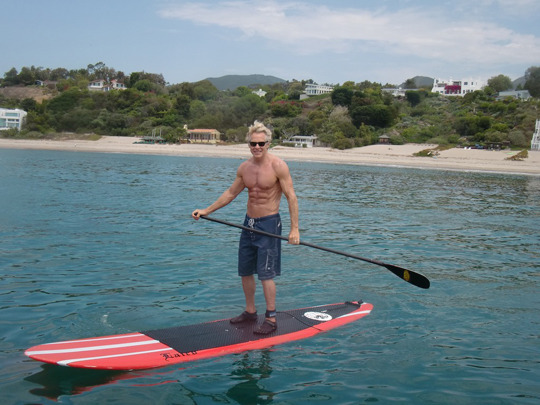
Of course, all this training is just a foundation for what I really love to do: play. I train so that I can play harder and not get injured. I strength train so that I can hang with the younger guys in Ultimate Frisbee, snowboard five days in a row or fight the waves when I’m standup paddle boarding. I sprint so I can beat the competition to the disc. I walk and hike so that I can spend all day out on the water if I want without losing steam. I slackline to improve balance and core strength. More than anything, I stay fit so that I can stay mobile and engaged in this life. At 60, I feel incredibly healthy and fit, perhaps more than ever before, and that’s no aberration. We can all stay this way, provided we eat well, exercise, and play as much as possible. We won’t all look or perform the same, but I’m serious when I say that everyone can be healthy and fit enough to enjoy their twilight years. It doesn’t have to be TV dinners, pill organizers, and dim, dreary living rooms illuminated only by daytime TV.
If you’re going to take anything away from the way I train to apply to your own training, start playing, guys. And start gearing your training toward supporting your mode of play.
That’s about it for my training these days. Some has changed, a lot has remained the same. What about you guys? How have you been working out these days? Thanks for reading, everyone.
Limited Time Offer: Get a FREE Copy of Primal Blueprint Healthy Sauces, Dressings & Toppings When You Order Primal Fuel Chocolate Coconut or Vanilla Coconut Creme on Autoship>>

July 28, 2013
Weekend Link Love
 Attention, Gmail users: Google is rolling out some changes to your inboxes that may affect how you receive emails from me. If you’ve got the new inbox, my emails will now show up in a tab called “Promotions.” To keep receiving my messages in your regular, or “Primary” inbox, simply drag one of my messages from your Promotions tab to the Primary tab, then click “Yes” when they ask you the question.
Attention, Gmail users: Google is rolling out some changes to your inboxes that may affect how you receive emails from me. If you’ve got the new inbox, my emails will now show up in a tab called “Promotions.” To keep receiving my messages in your regular, or “Primary” inbox, simply drag one of my messages from your Promotions tab to the Primary tab, then click “Yes” when they ask you the question.
Research of the Week
In a recent small trial in patients with major depressive disorder, curcumin, a constituent of turmeric root, was just as effective as Prozac at improving the depression rating scale.
Why we like talking about ourselves (even if no one else is around): it triggers reward centers in the brain.
Interesting Blog Posts
The problem (or not) with pictures.
The physiological nitty gritty behind how we learn new skills.
Media, Schmedia
The truth behind (some) transformation photos.
How a ketogenic diet helped a previously mute three year-old girl begin to speak.
Everything Else
Our friend Abel James over at Fat-Burning Man has recently released a paleo recipe app for the iPhone/iPad. It was the #6 app in the world this week – ahead of Angry Birds! Check it out here on his blog, and here on iTunes.
The recent revelations that the cows behind Kerrygold butter may get a little supplementary feed, a little bit of which may contain GMOs has apparently caused a host of people to swear it off forever. What do you think?
I’d pay good money for this salad to be served in a vegan restaurant.
Recipe Corner
When you make Kenyan braised collard greens and ground beef, the trick is keeping that vibrant color of the greens. If you don’t, it’ll still taste good, but it won’t be as pretty.
Pork belly carnitas: an absolutely genius idea that I wish I’d thought of earlier.
Time Capsule
One year ago (July 28 – Aug 3)
Dear Mark: Should I Increase Carb Intake for Weight Loss? – Why it might make sense to add carbs to spur weight loss, for certain people under certain parameters.
When Listening to Your Body Doesn’t Work – We’d like to believe the messages and signals our bodies send us, because it’d be pretty easy to stay healthy. Unfortunately, the body is not always a reliable narrator.
Comment of the Week
haha, when reading through this article that was the first thing that came to mind, you beat me to it.
“The only permanent rule in Calvinball is that you can never play it the same way twice!”
Limited Time Offer: Get a FREE Copy of Primal Blueprint Healthy Sauces, Dressings & Toppings When You Order Primal Fuel Chocolate Coconut or Vanilla Coconut Creme on Autoship>>

July 27, 2013
Garlic Soup with Mushrooms and Chive Oil
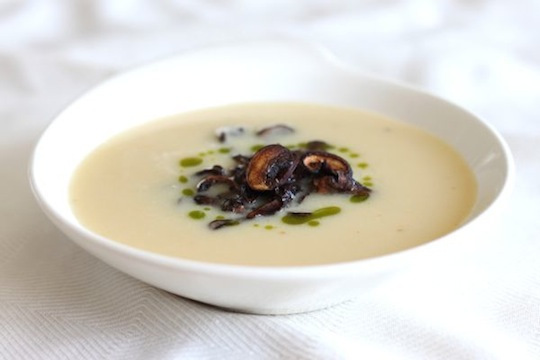 Don’t be scared off by the amount of garlic in this soup. Yes, the number of cloves is way up there, somewhere around 40, but the resulting flavor is smooth, mellow garlic without any bite. The texture is just as enticing, creamy and rich without any cream or coconut milk added.
Don’t be scared off by the amount of garlic in this soup. Yes, the number of cloves is way up there, somewhere around 40, but the resulting flavor is smooth, mellow garlic without any bite. The texture is just as enticing, creamy and rich without any cream or coconut milk added.
Organosulfur compounds that show potential for preventing cancer can be found in garlic and leeks. Both of these sulfur-rich veggies are swirling around in this delicious soup, plus a bright-green drizzle of chive oil.
Cooking alliums does break down the sulfur compounds somewhat, making them less potent, but slicing garlic and onions at least ten minutes before cooking makes them more resistant to heat. Keep this in mind when you begin prepping the recipe.
While the garlic flavor in this soup is mellow, the chive oil has a real kick. A little bit of this intensely aromatic oil goes a long way. Drizzle some in this soup and use the rest throughout the week for sautéing, making salad dressing and drizzling over just about anything.
Servings: 4
Time in the Kitchen: 1 1/2 hours
Ingredients:
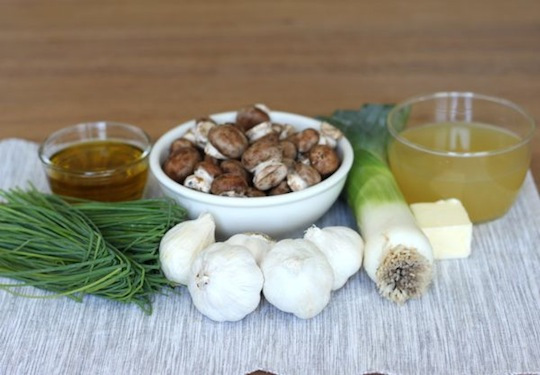
2 bunches of chives, roughly chopped (about 1.5 ounces/42 g)
1 cup extra virgin olive oil (240 ml)
3 whole heads of garlic
15 raw cloves of garlic, peeled and sliced in half
12 to 16 ounces mushrooms, thinly sliced (340 to 450 g)
2 tablespoons unsalted butter (30 g)
1 leek, thinly sliced
3 1/2 cups chicken stock (820 ml)
Salt and pepper
Instructions:
In a blender, purée the chives with the olive oil until the chives are very finely chopped and the consistency of the oil is fairly smooth. Be patient, this will take several minutes.
In two batches, strain the oil through a fine sieve. Let the oil drip out on its own; don’t push down on the solids or the chive oil will be cloudy. Discard the solids. Add a pinch of salt to the oil. Set aside. (The oil will keep for at least a week in the fridge.)
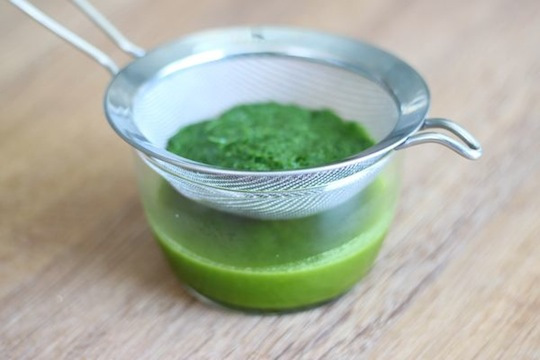
Preheat oven to 400 °F (204 °C).
Peel off any loose layers of white skin on the three heads of garlic then slice the top off to expose the tops of the cloves. Drizzle a little olive oil on top of the heads. Season with salt and pepper. Wrap each head in foil or parchment paper (tie parchment up with a string) or put them in a tightly covered baking dish.
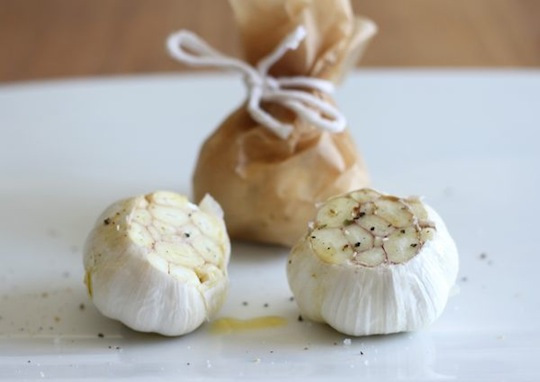
Put the heads of garlic in the oven and roast until the cloves are tender and easy to pierce with a fork, about 35 minutes. When the garlic has cooled, squeeze the roasted cloves into a small bowl.

Spread the mushrooms out on a baking pan. Drizzle with olive oil and lightly season with salt and pepper.
Put the pan of mushrooms in the oven at the same time as the heads of garlic, roasting until soft, about 20 minutes. Stir the mushrooms occasionally.
Melt butter in a saucepan over medium-high heat. Add the leek and cook until soft.
Add the roasted garlic and raw garlic cloves and sauté for a few minutes.
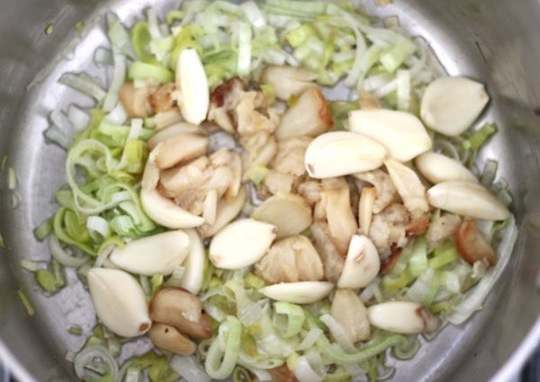
Add chicken stock. Cover and simmer until the raw garlic cloves are very tender, about 20 minutes.
Working in batches, purée the soup in a blender until smooth.
Heap mushrooms in the middle of each soup bowl and drizzle in chive oil.

Not Sure What to Eat? Get the Primal Blueprint Meal Plan for Shopping Lists and Recipes Delivered Directly to Your Inbox Each Week

July 26, 2013
I Am in the Best Health and Shape of My Life
It’s Friday, everyone! And that means another Primal Blueprint Real Life Story from a Mark’s Daily Apple reader. If you have your own success story and would like to share it with me and the Mark’s Daily Apple community please contact me here. I’ll continue to publish these each Friday as long as they keep coming in. Thank you for reading!
 Shame and disgust were what I felt when I first saw this cringe-worthy photo of myself. I am a deaf mom of three boys. This picture was taken in July 2009, five years after my youngest son was born. I was fast approaching 40 years old. I did not have a weight problem growing up as I was very active and played in several sports. It was when I got to college that I gained the infamous “Freshman Fifteen”. I successfully lost my pregnancy weight with my first son. However, more pounds creeped up from the next two pregnancies. In the July 2009 photo I was hovering between 185 and 195 pounds and by the way, I’m 5’8″. I would delete, throw it out or crop off the bottom half of me in every full-body picture taken of me. My instincts told me to keep this one and I now know why.☺ I love receiving your weekly Friday Primal Blueprint Success Story e-mail and always feel inspired by whoever had the courage to share his/her story. I want to share my story and help others find the magic in themselves.
Shame and disgust were what I felt when I first saw this cringe-worthy photo of myself. I am a deaf mom of three boys. This picture was taken in July 2009, five years after my youngest son was born. I was fast approaching 40 years old. I did not have a weight problem growing up as I was very active and played in several sports. It was when I got to college that I gained the infamous “Freshman Fifteen”. I successfully lost my pregnancy weight with my first son. However, more pounds creeped up from the next two pregnancies. In the July 2009 photo I was hovering between 185 and 195 pounds and by the way, I’m 5’8″. I would delete, throw it out or crop off the bottom half of me in every full-body picture taken of me. My instincts told me to keep this one and I now know why.☺ I love receiving your weekly Friday Primal Blueprint Success Story e-mail and always feel inspired by whoever had the courage to share his/her story. I want to share my story and help others find the magic in themselves.
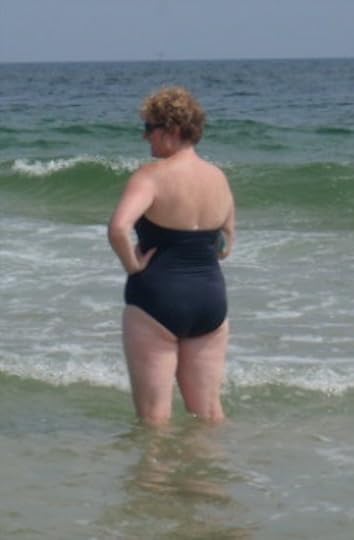
I was not much of a yo-yo dieter. Weight Watchers and the Atkins Diet were the only programs I tried. I would lose maybe ten pounds at most but the weight always returned over time. That was when I decided to take up running for the first time. I never ran in my entire life except for what I had to do as part of organized sports programs. It took me two failed attempts to succeed on the Couch to 5k program. I couldn’t follow the program timeframe. I had to go at my own pace and that meant repeating some of the weeks to allow my body to catch up. I ran my first marathon two years later. As you would see the photo below, I still had not lost very much weight in spite of running on almost a daily basis. I was always hungry and I ate more. Does this sound familiar?
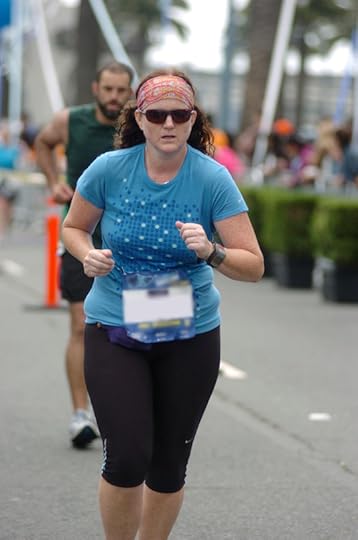
I was diagnosed with celiac disease in 2005 after becoming ill with a full-blown celiac-episode overnight. After two weeks my health was not improving. I had not had any obvious symptoms prior to that and nobody in my family had celiac disease so, needless to say, being diagnosed was a big shock. I went on the gluten-free diet right away and followed it to a “T”. At around the same time, I developed year-round seasonal allergies leading to constantly recurring sinusitis. Chronic fatigue and joint pain made themselves at home in my body.
I started having major anxiety attacks out of the blue and I blamed it on peri-menopause even though I was tested negative for it. I was prescribed Xanax and I never took it. I’ve never liked taking medicine. I kept the bottle in my purse and would just look at it to calm myself down whenever I felt an attack coming up. At the same time, I was put on the allergen immunotherapy program (weekly shots) and my body reacted violently. I had suicidal thoughts and my anxiety attacks worsened. I pulled myself off the immunotherapy program after a few months and stopped taking the allergy medicine completely. I decided to live with the stuffed up nose year round. I was also having ongoing stomach pains and bloatedness even though I was religiously careful about avoiding the gluten cross-contamination. I had an endoscopy and the gastrointestinal nuclear scan, which revealed only gastritis of the stomach lining. Everything else looked healthy. My doctor prescribed Nexium for my stomach pain. I threw the prescription out when I got home because I knew he had not gotten to the root of my problem.
Needless to say, I was frustrated with all of my health issues. They were popping up out of nowhere. For someone who is a lifelong optimist I started to think, why me?
It was through a friend when I first heard of the paleo lifestyle. He kept talking about how bacon is good for you and how his health problems were resolved. I became intrigued and did my own research. I was still skeptical but I decided I had nothing to lose by giving it a try. I removed every processed food; Diet Pepsi, sugar, and the rest of the gluten free junk food from my kitchen. I ate bacon every morning. In a matter of days, my stomach pains completely disappeared. Bloatedness gone. My energy levels skyrocketed. Most of my allergy symptoms vanished. My joint pain faded away. I had a much improved skin complexion with no more acne. I was STUNNED! Who knew that food was the culprit of all those health problems I had?!?! Five months later, I decided to remove dairy from my diet for 30 days. Lo-and-behold, the remaining allergy issues went away. Even though I was tested negative for lactose intolerance, I now know I have histamine intolerance to dairy. I no longer eat dairy. I now see the importance of removing certain foods from the diet for a period of time to see how the absences of these foods positively affect your bodies. What I love about the paleo diet is that there is no calorie counting. There is no marketing gimmick. There is no requirement to pay for any diet program. The information is all right there at your fingertips with the help of Almighty Google.
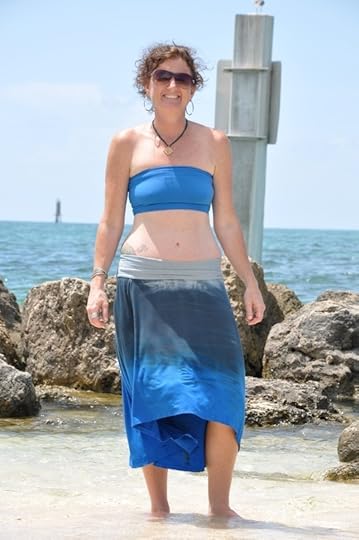
After turning to the paleo lifestyle, I ran four marathons in five months. Three of them were part of the 3N3 Alabama Challenge (3 marathons in 3 months). The energy I gained from the paleo lifestyle made this possible without any injuries or fatigue. Then this past March, an “uh-oh” happened. I broke my foot during a mountain hike. I had to put my running on the back burner. Restlessness was getting the best of me. I had to find another exercise outlet. This helped me find Bikram Yoga. I could not run on my injured foot but I had no problem standing on it. I became hooked to hot yoga and I now go six days a week. That broken foot was a blessing in disguise, indeed. I’ve come to understand that long distance/endurance running is not exactly good for my body; putting too much stress and raising my cortisol level. I’ve gone back to running but it is not as often as I used to. I may do one marathon a year. I’m now all about Namaste-ing.

To date after 11 months, I’ve lost a total of 35 pounds. I would love to lose the last ten elusive pounds to reach my high school weight. I am just so elated that I am in the best health and shape of my entire life. I have become so passionate about the paleo lifestyle that with the help of the friend who introduced me to it, we created a Facebook group, “DeafPaleo” to help educate and inspire others in the deaf community. I so desperately want them to become aware of the healing power of proper nutrition and exercise and to lower dependence on the pharmaceutical industry to help get them through life. We now have 612 members and it continues to grow. Because I am still learning about the paleo stuff, I do not always have the answers immediately when they ask questions. I am always asking myself, “What does Mark have to say about that?” and I resort to your website for helpful answers. Thank you for being there, Mark.
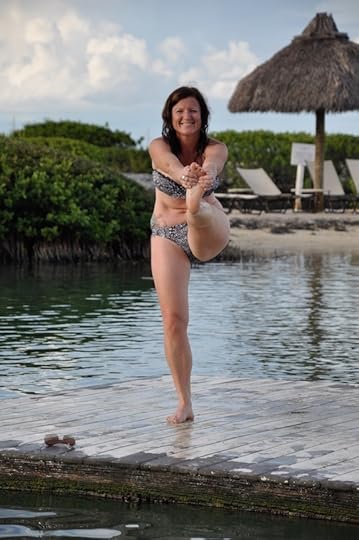
Beth
Limited Time Offer: Get a FREE Copy of Primal Blueprint Healthy Sauces, Dressings & Toppings When You Order Primal Fuel Chocolate Coconut or Vanilla Coconut Creme on Autoship>>

Mark Sisson's Blog
- Mark Sisson's profile
- 199 followers



